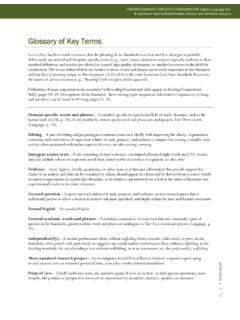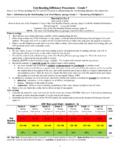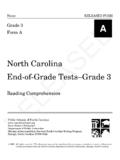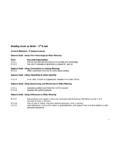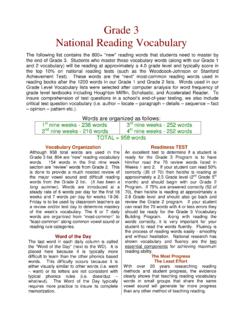Transcription of Reading/Literature Sample Test 2011-2013 - Grade 3
1 VocabularyRead to Perform a TaskDemonstrate GeneralUnderstandingDevelop an InterpretationExamine Content and Structure: Informational TextExamine Content and Structure: Literary TextReading/Literature2011-2013S A M P L ET E S TGRADE 3It is the policy of the State Board of Education and a priority of the Oregon Department of Education that there will be no discrimination or harassment on the grounds of race, color, sex, marital status, religion, national origin, age or handicap in any educational programs, activities, or employment. Persons having questions about equal opportunity and nondiscrimination should contact the State Superintendent of Public Instruction at the Oregon Department of Education. Office of Assessment & Information Services Oregon Department of Education 255 Capitol Street NE Salem, OR 97310 (503) 947-5600 Susan Castillo State Superintendent of Public Instruction Ken Hermens Language Arts Assessment Specialist Doug Kosty Assistant Superintendent James Leigh Mathematics Assessment Specialist Steve Slater Manager, Scoring, Psychometrics and Validity Dianna Carrizales Director, Monitoring, Systems, and Outcomes Kathleen Vanderwall Manager, Test Design and Administration Bradley J.
2 Lenhardt Monitoring and Assessment Specialist Holly Carter Assessment Operations and Policy Analyst Sheila Somerville Electronic Publishing Specialist Michelle McCoy ELPA and Assessment Implementation Specialist Kathy Busby Project Manager reading and Literature Office of Assessment and Information Services 2011-2013 Sample Test, Grade 3 Oregon Department of Education 1 August 2011 DIRECTIONS Read each of the passages. Then read the questions that follow and decide on the BEST answer. There are a lot of different kinds of questions, so read each question carefully before marking an answer on your answer sheet. A THORNY PROBLEM Read this story by Gertrude Chandler Warner to find out how Jessie and her family carefully help a dog in trouble.
3 JESSIE WHISPERED, KEEP STILL! The three children did not say a word. They sat quietly in the boxcar, looking at the bushes. I wonder if it s a bear, thought Benny. Soon something came out. But it wasn t a bear. It was a dog, which hopped along on three legs, crying softly and holding up a front paw. It s all right, said Jessie. It s only a dog, but I think he is hurt. The dog looked up and saw the children, and then he wagged his tail. Poor dog, said Jessie. Are you lost? Come over here and let me look at your paw. The dog hopped over to the boxcar, and the children got out. Jessie looked at the paw and said, Oh, dear! You poor dog! There is a big thorn in your foot. reading and Literature Office of Assessment and Information Services 2011-2013 Sample Test, Grade 3 Oregon Department of Education 2 August 2011 The dog stopped crying and looked at Jessie.
4 Good dog, said Jessie. I can help you, but maybe it will hurt. The dog looked up at Jessie and wagged his tail again. Violet, ordered Jessie, please wet my handkerchief in the brook. Jessie sat down on the stump and took the dog in her lap. She patted him and gave him a little piece of bread. Then she began to pull out the thorn. It was a long thorn, but the dog did not make any noise. Jessie pulled and pulled, and at last the thorn came out. Violet had a wet handkerchief ready. Jessie put it around the dog s paw, and he looked up at her and wagged his tail a little. He wants to say Thank You, Jessie! cried Violet. He is a good dog not to cry. Yes, he is, agreed Jessie. Now I had better hold him awhile so that he will lie down and rest his leg.
5 1 From the way it is talked about in the story, you can tell that a brook is most like A. a tree. B. a stream. C. a thorn. D. a tongue. 2 From the story and the two parts of the word, what do you think boxcar means? A. A train car that is in a box shape B. A small cardboard box C. A box that holds toy cars D. A car that holds boxes reading and Literature Office of Assessment and Information Services 2011-2013 Sample Test, Grade 3 Oregon Department of Education 3 August 2011 3 From Jessie s actions in this story you can tell she is A. the youngest in her family. B. kind to animals. C. bossy to her sister. D. afraid of animals. 4 Why did Jessie whisper when she said, Keep still! in this story?
6 A. She didn t want to wake up Violet. B. She didn t want them to scare the dog. C. She didn t want to bother the neighbors. D. She didn t want what was in the bushes to hear them. 5 Why did Jessie want to keep the dog in her lap after taking out the thorn? A. She was afraid the dog would run away. B. She wanted the dog to rest his leg. C. She thought there might be more thorns to take out. D. She didn t want to share the dog with the other children. A SON REMEMBERS Dr. Martin Luther King Jr. was an important man in United States history. This article is about both his family and his important work. Read it to learn about this special man. AS A YOUNG BOY, Martin Luther King III liked to play sports with his father, Dr.
7 Martin Luther King Jr. They swam and rode bikes together. We also played baseball in the backyard, Martin says. However, the Kings were not free to do all the things they enjoyed. For example, they could not go to an amusement park near their home in Atlanta, Georgia. A law prevented them from going because of their skin color. Laws also kept children of different races from attending the same reading and Literature Office of Assessment and Information Services 2011-2013 Sample Test, Grade 3 Oregon Department of Education 4 August 2011 schools. Dr. King worked to change unfair laws like these. He led peaceful marches and gave many speeches. He traveled a lot to fight prejudice in different places in the country, Martin says.
8 Prejudice is hatred or unjust treatment based on unfair opinions about a group of people. Dr. King convinced most Americans that all people should be treated fairly. The laws began to change. As a third-grader, Martin was among the first African-American children in the South to go to school with white children. Dr. King was killed in 1968. Today, Martin leads a group started by his father. The group wants to make America a better place for all people. Have hope! Martin says. By working together as one community, we can solve our problems. 6 Why did Dr. King travel so much? A. He liked to see lots of different places. B. His parents lived in another part of America. C. The company he worked for sent him.
9 D. He was fighting prejudice all over America. 7 As used in this selection, the word prevented means A. stopped. B. encouraged. C. allowed. D. attended. reading and Literature Office of Assessment and Information Services 2011-2013 Sample Test, Grade 3 Oregon Department of Education 5 August 2011 8 Which statement best describes the main idea of this selection? A. Dr. King was a good dad who played sports with his son. B. Martin went to third Grade at a school with white children. C. Dr. King s family was not allowed to go to the amusement park. D. Dr. King worked to change laws to help African-Americans. 9 Dr. King worked to change laws in our country. Why did he choose to lead marches and make speeches in order to make the changes?
10 A. He didn t know how laws were made in America. B. He was too young to have any other job. C. He wanted many people involved and paying attention. D. He was too busy with his family to try other things. 10 In the passage, it says Dr. King traveled to fight prejudice. What does prejudice mean? A. Thoughtfulness B. A disease C. Unfair treatment D. A baseball team CONTINUE ON TO THE NEXT PAGE reading and Literature Office of Assessment and Information Services 2011-2013 Sample Test, Grade 3 Oregon Department of Education 6 August 2011 ENJOYING LIFE The country of Thailand has many festivals. Read about some of them in this chart in order to answer a few questions 11 If you traveled to Thailand in October, which festival might you see?








